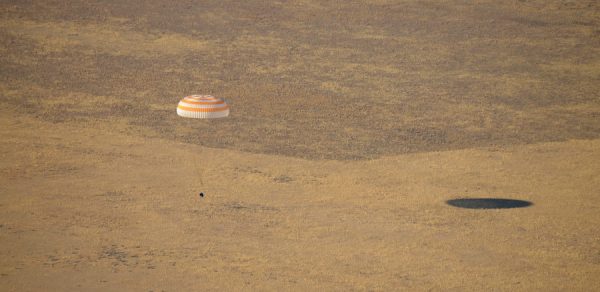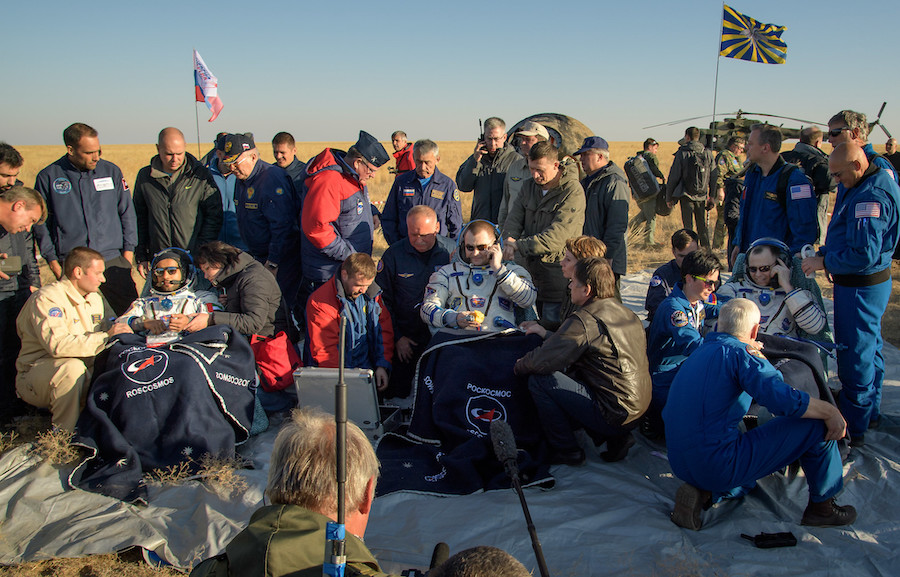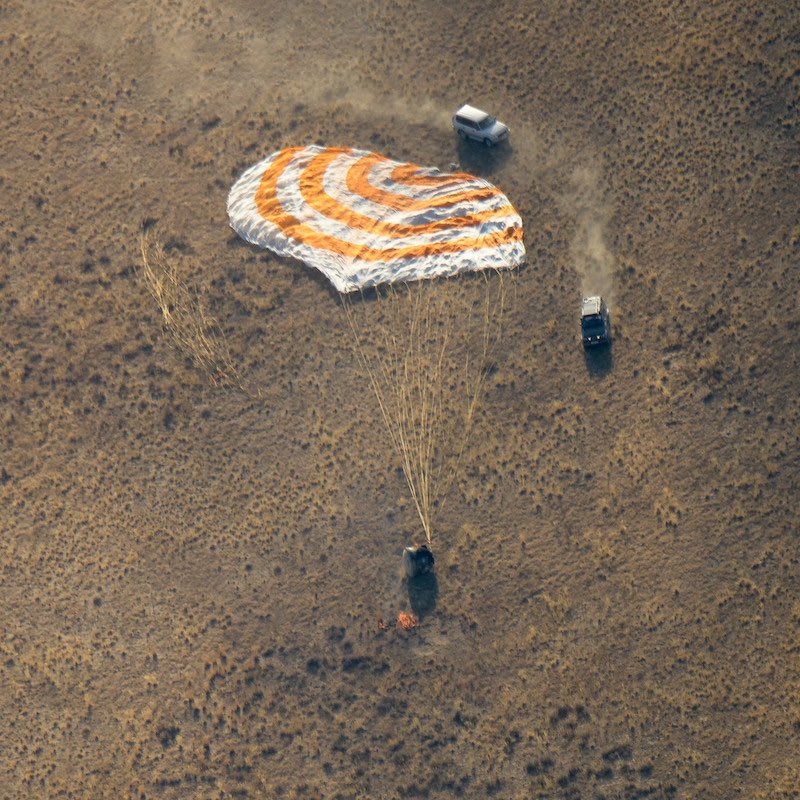Soyuz spacecraft lands in Kazakhstan with three-man crew – Spaceflight Now
STORY WRITTEN FOR CBS NEWS & USED WITH PERMISSION

Leaving six crewmates behind in orbit, a Russian commander, his NASA co-pilot and a first-time flier from the United Arab Emirates undocked from the International Space Station early Thursday, executed a fiery plunge back to Earth and landed safely on the steppe of Kazakhstan.
Helped out of the cramped Soyuz descent module by waiting recovery crews, all three appeared healthy and in good spirits as they rested in recliners near their spacecraft, undergoing initial medical checks and chatting with friends and family by satellite telephone as they began re-adjusting to the unfamiliar tug of gravity.
It was a picture-perfect ending for a trip that began at 3:37 a.m. EDT when the Soyuz MS-12/58S spacecraft undocked from the space station’s Russian Rassvet module.
Strapped into the Soyuz’s central crew compartment were vehicle commander Alexey Ovchinin, NASA flight engineer Nick Hague and “spaceflight participant” Hazzaa Ali Almansoori. Ovchinin and Hague, launched to the station on March 14, were closing out a 203-day mission while Almansoori, a guest cosmonaut who arrived at the outpost Sept. 25, was wrapping up a relatively short eight-day visit.
After moving the Soyuz a safe distance away from the station, Ovchinin and Hague monitored a four-minute 42-second rocket firing starting at 6:06 a.m. The braking burn was designed to slow the ship by about 286 mph, just enough to drop the far side of the orbit deep into the atmosphere for a landing in Kazakhstan.
The rocket firing went off without a hitch and a half hour later, just before atmospheric entry, the three modules making up the Soyuz MS-12/58S spacecraft separated as planned. The crew module, the only one equipped with a protective heat shield, then plunged back to a parachute and rocket-assisted landing near the town of Dzhezkazgan, touching down at 6:59 a.m. (4:59 p.m. local time).
Russian recovery teams, NASA personnel and UAE officials stationed nearby welcomed the crew back to Earth with fresh fruit and water. After more detailed medical checks, Ovchinin and Almansoori planned to head back to Star City near Moscow while Hague boarded a NASA jet in Karaganda for the long flight back to the Johnson Space Center in Houston.

Left behind in orbit aboard the space station was the six-member Expedition 61 crew, made up of Italian commander Luca Parmitano, cosmonauts Alexander Skvortsov and Oleg Skripochka and NASA astronauts Christina Koch, Drew Morgan and Jessica Meir.
They face one of the busiest schedules in recent memory with up to a dozen spacewalks planned by the end of the year — five to install fresh batteries in the station’s solar power system, five and possibly six to repair a $2 billion particle physics experiment and one to carry out maintenance on the Russian segment of the lab complex.
The first battery swap-out spacewalk, with Koch and Morgan, is planned for Sunday.
The station crew may also welcome a U.S. commercial crew ship to the station at some point during their stay. Boeing and SpaceX are in the final stages of readying ferry craft for launch that NASA is counting on to end the agency’s sole reliance on the Russian Soyuz to carry astronauts to and from the station.
But both company’s have had major problems and it’s not clear when either will be ready for operational flights. As it now stands, the final NASA-booked seat aboard a Soyuz will be used on the next Russian crew fight to the station in April. NASA managers are reportedly considering the purchase of additional seats — at more than $80 million each – to ensure an uninterrupted U.S. presence aboard the station.
For Hague and Ovchinin, Thursday’s return to Earth closed out an extraordinary year that began with an initial attempt to reach the space station last October. Two minutes after launch, their normally reliable Soyuz booster malfunctioned and broke apart, triggering a dramatic — but safe — emergency abort.
Russian engineers quickly found and corrected the problem and Roscosmos, the Russian space agency, resumed Soyuz flights two months later. Hague and Ovchinin then were reassigned to the Soyuz MS-12/58S spacecraft and, joined by Koch, they finally made it into orbit on March 14.

“This year has definitely been a crazy year,” Hague told CBS News in a space-to-ground interview Wednesday. “Finally making it up here in March was just … a mix of emotions — the relief of finally accomplishing it, knowing the sacrifice that had been put in up to that point, not just by me, but my family.
“It’s something uncommon to ask a family to sit there and witness a rocket disintegrate with someone they love strapped to the top of it and then to turn around and ask them to do that again five months later. That’s quite something for them to go through. It’s really brought home just how important it is what we’re doing up here, and why it’s all worth it.”
He said his time in orbit was a more moving experience than he expected.
“I didn’t fully appreciate just how significant that change is, to be able to look down and see the Earth for what it is, this one giant organism that is alive and it’s constantly changing and we’re part of that,” he reflected. “And to just understand that we’re part of this precious place.”
Describing Earth as “this precious island in this abyss of darkness around us,” Hague said the experience made him realize “I’m part of something larger than myself, I’m part of planet Earth.”
“It also brings home a sense of stewardship in terms of this is our planet, and we need to do everything we can to make sure we preserve that for future generations. The change in perspective up here is profound, and you can definitely feel it.”
Asked if he was looking forward to the trip back to Houston, he said “I’m sure definitely ready to give my wife and kids a huge hug.”






